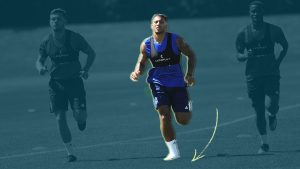ASCA Pro-Scheme Associate Coach
ASCA Level 2 Strength and Conditioning Coach
Maximal aerobic speed (MAS) is quite simply the minimal running velocity at which V02 max occurs – otherwise known as the velocity at V02 max (vV02 max).
To put it more simply, it is the lowest speed at which maximum oxygen uptake (V02 max) occurs.
Now, why is this important to understand as an athlete?
Given that most field sports (i.e., Rugby, Touch Football, Football (Soccer) etc) have a high level of aerobic involvement as well as the requirement of the athlete to perform high intensity efforts throughout their game it would appear obvious that a high level of aerobic power is required.
Now it is important to understand that the higher the demand required within the sport, the greater the MAS requirement is for the athlete to compete at a high level.
Here are some sporting examples of MAS scores.

How do you test an athlete’s MAS?
Importantly, for running-based field sport athletes, it is highly recommended that MAS is assessed using a running-based test to ensure accurate scoring.
Over the years many running-based MAS tests have been developed, so picking the right one can be a difficult decision when the practitioner is uninformed of the strengths and weaknesses of each test.
Below is a table outlining the various tests.

As you can see, all the tests are different in nature.
Some involve linear running, others involve shuttle-based running, some are continuous, others are incremental, and some are steady-paced, whilst others are timed. It is absolutely vital that the sports scientist or strength and conditioning coach understands the difference between these tests in terms of their nature.
Shuttle-based tests include constant deceleration, change of direction and acceleration which are considered high intensity and that these actions add an anaerobic element to the test, which is typically not present during continuous, linear running tests.
As a result of these high intensity actions, the aerobic system demand is higher as the body works harder to replenish the anaerobic stores used during the test.
It is therefore understood that shuttle-based tests result in lower and inaccurate MAS scores, if not corrected for.
MAS Corrections
Multistage Fitness Test – Corrective Equation
MAS (km/h) = Final Shuttle Speed (km/h) * 1.34 – 2.86
1200m Shuttle Test
Equation for athletes with a heavy body mass (approx. 100 kg)
MAS (m/s) = 1200 / (time in seconds – 29)
Equation for athletes with a light body mass
MAS (m/s) = 1200 / (time in seconds – 20.3)
Generic “corrective” Equation
For other tests, a generic “corrective” calculation is typically applied:
MAS (m/s) = Estimated V02 max / 3.5
Tests without their own specific corrective equation can use a simple generic formula.
Maximal aerobic speed, otherwise known as MAS, is a useful tool for measuring performance, training prescription, and monitoring training loads.
However, it is important that the coaches understand the effects of each test used on the athlete or team, can identify, and implement the correct test for assessment as well as appropriately apply corrections to attain the athlete’s score.
References
Walker, O (2017, August 28). Maximal Aerobic Speed. Retrieved from Science for Sport: https://www.scienceforsport.com/maximal-aerobic-speed-mas
Berthoin S, Gerbeaux, M, Geurruin F, Lensel-Corbeil G and Vandendorpe F. Estimation of maximal aerobic speed. Science & Sport 7(2), 85-91.1992.
https://www.sciencedirect.com/science/article/pii/S0765159705801790
Baker, D. & N. Heaney. Normative Data for Maximal Aerobic Speed for Field Sport Athletes: A Brief Review. Journal of Australian Strength & Conditioning (in review)
Buchheit M. The 30-15 Intermittent Fitness Test: accuracy for individualizing interval training of young intermittent sport players. J Strength Cond Res 22: 365-374, 2008.
Léger, L.; Mercier, D. Gross energy cost of horizontal treadmill and track running. Sports Medicine. 1 (4): 270–277. 1984.




